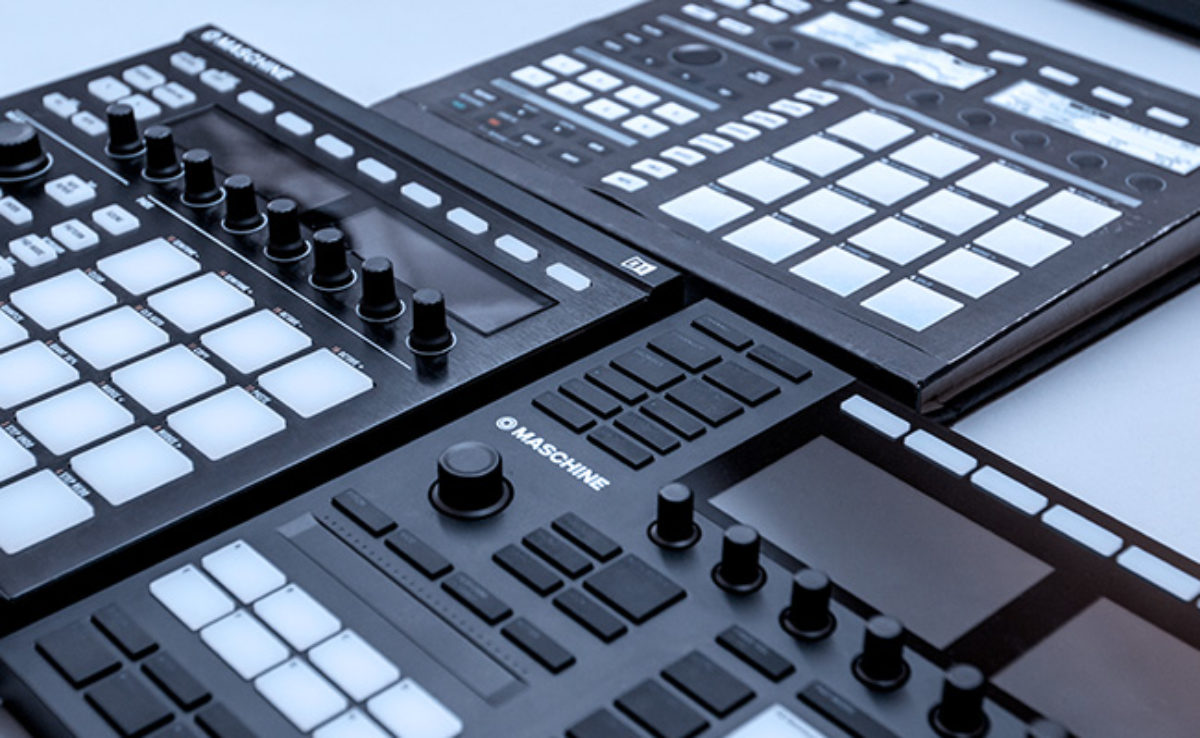
Mockups, prototypes, and finished products in various states of deconstruction line each wall of a room on the fourth floor of Native Instruments’ Berlin headquarters. On a table in the center rests the new MASCHINE and KOMPLETE KONTROL hardware – the combined output of two years of work by dedicated teams of designers and engineers. Among them are industrial designers Johannes Schroth and Mino Kodama, who talk us through some of the thinking behind the new products.
With a sleek, unified aesthetic, the new MASCHINE and KOMPLETE KONTROL hardware is a noticeable departure from NI’s previous output. Most prominently, both units now feature large color screens with a row of RGB buttons along the top and touch-sensitive knobs along the bottom. The distinctive raised bezels previously found along the top and bottom edges of MASCHINE are gone, making way for larger pads, and extra controls, while the low-key black enclosure is mirrored by that of the keyboard, which now sports physical pitch and mod wheels along with a single touch strip.
“It’s not necessarily the materials, the shape they’re formed into, or the branding that defines Native Instruments products,” explains Kodama. “It’s more about how they sit, and how simple and clean they are.” This realisation allowed NI’s designers the freedom to rethink the visual language of the company’s hardware.
The process kicked off with a series of workshops, with designers and engineers invited to bring their ideas – small or large – to the table. “We took inspiration from the automotive industry, consumer electronics… all over, really,” explains Kodama. “If we simply reacted to the music tech gear that’s out there today, we’d already be behind by the time we released anything.”

Through a process of constant prototyping, user testing, and refinement, the team gradually progressed from paper mockups to working prototypes to finished products. “People were happy with the previous MASCHINE, but showing them the new hardware was always a nice moment. Their reactions showed that we had the right intentions,” says Kodama.
One of the best received changes to the new MASCHINE is the increase in pad size. Stemming from an early workshop concept of a continuous, playable membrane, the 16 pads have effectively been brought closer together, while retaining the same centre-to-centre distance. This last point is a crucial one. “Experienced MASCHINE users have developed muscle memory from hours and hours of playing, and it’s important that they feel at home on the new hardware,” explains Schroth. For less experienced users, it’s now easier to hit the right pad or to play a single pads with more than one finger.
Immediately above the new pads are four Pad Input Mode buttons. As the MASCHINE software has developed over the years, new features like Keyboard and Chord modes have been introduced. While proving a hit with users, accessing these new modes from hardware has always been something of a workaround. The latest iteration of the hardware places instant access right where it’s needed.

The new KOMPLETE KONTROL has been similarly optimized. Careful UX testing and evaluation of the signature Light Guide, for example, revealed that slimming down the individual lights makes it easier to see which light corresponds to which key. DAW functionality has been expanded well beyond the transport control of the original version, with a cluster of buttons on the left hand side of the keyboard now giving access to automation, quantisation, undo/redo and more in addition.
With added functionality, there’s a risk of added complexity. This, coupled with the absence of the screen-printed labelling found on the bodies of previous generations, had potential to cause confusion among users. Happily, any such concerns proved unfounded. Within a few minutes of play, most people had figured out the location of all the most important controls.
“We have smart users,” smiles Kodama. “But as much as we always want to add exciting new features, it’s important not to change so much that we alienate people. The touch strip on MASCHINE and the new pitch and mod wheels on KOMPLETE KONTROL contribute to what we call ‘the tangible experience’ by adding new modes of interaction. A theremin control, however, might be a step too far at this point,” she jokes.

It’s clear from speaking with Schroth and Kodama that, along with the input from hundreds of user input and review sessions, a great deal of thought has gone into each element of these new products – and not just from an industrial design perspective. “No one person could have made these products by themselves,” says Schroth, acknowledging the contribution of NI’s product designers, electrical engineers, QA engineers, and other specialists.
“We could only have done this as a team,” he continues. “Under the umbrella of this project, we’ve come closer together as a team – and the results are also getting closer and closer to perfection.
“All things considered, this has probably been the most rewarding projects we’ve worked on.”















